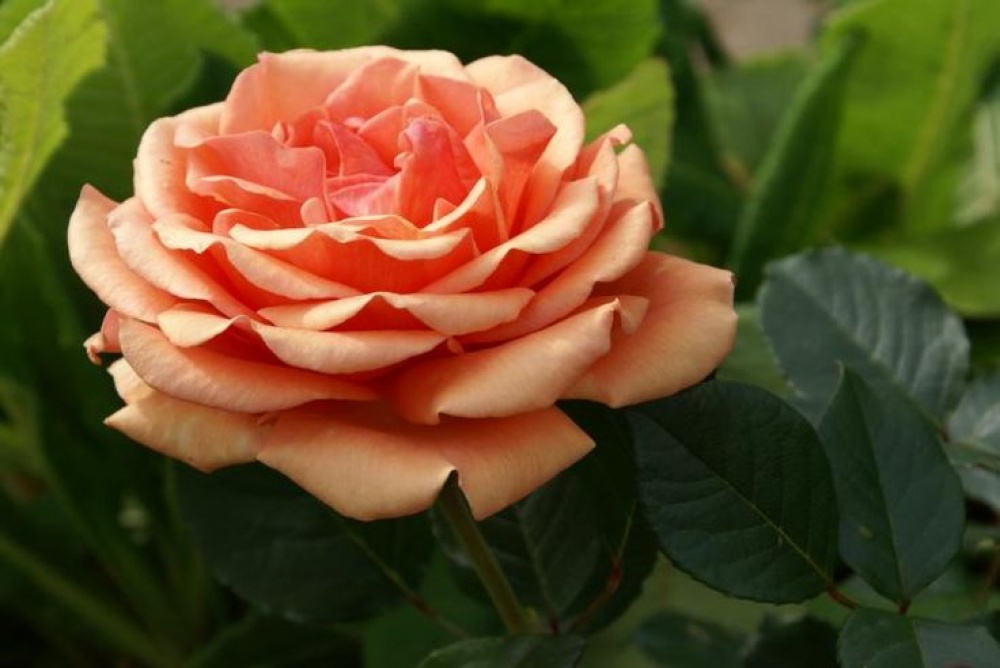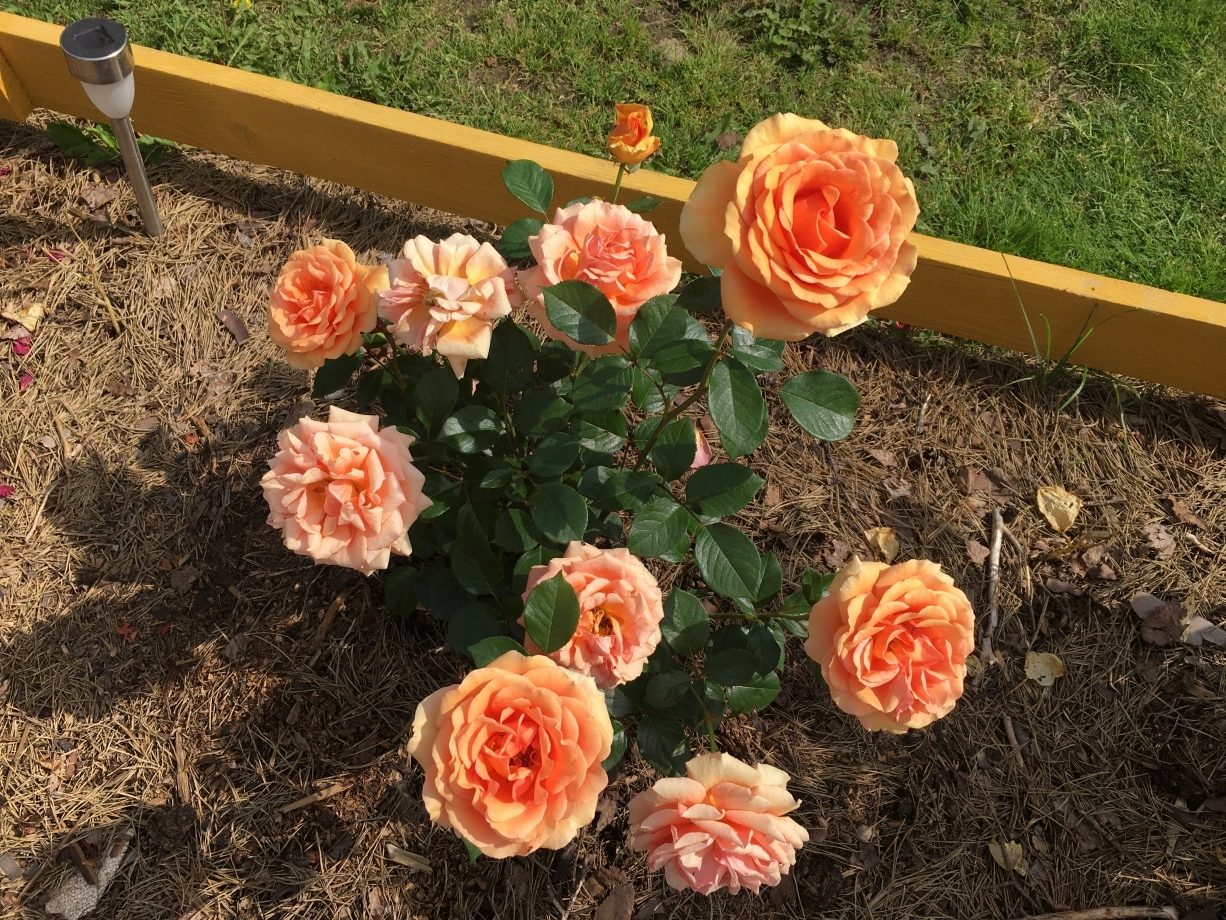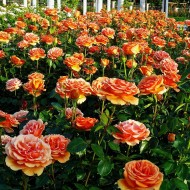What is remarkable about the hybrid tea rose Ashram: description and cultivation
Content
- 1 The history of the appearance of the rose Ashram
- 2 Description and characteristics of the variety
- 3 Advantages and disadvantages
- 4 Video "Description of the Rose Ashram"
- 5 Recommendations for flower growers for planting and care
- 6 Dangerous diseases and pests
- 7 Variants of using rose Ashram in garden design
- 8 Variety reviews
The history of the appearance of the rose Ashram
The eastern name of the flower can cause a misconception about the place of origin of the rose. In fact, the authorship of the variety belongs to a European concern known throughout the world for its unique aristocratic decorative and floral cultures. Ashram is another masterpiece of breeders of the German rose-growing company Tantau.
This tea hybrid appeared 21 years ago and still continues to enjoy popularity, becoming one of the most sought-after flower crops. The name of the culture is translated as "protection" and "secret refuge of sages and hermits." Other variety names can be found in the catalogs: TANmarsa and TAN01106.

Description and characteristics of the variety
The Ashram bush itself is quite compact and neat, it grows to 0.7 m, about 0.6 m in diameter.Taller and sprawling specimens are very rare. But at the same time, the shoots are strong, upright, with large leaf plates of a classic shape, but slightly elongated. The color of the leaves is deep green, the surface can be glossy and matte.
The main asset of the variety is undoubtedly its flowers. Large goblet buds are very dense, up to 5 cm high. The diameter of a blossoming flower varies from 10 to 16 cm. Most often, only one flower appears on one shoot, less often several. The petals slightly bent towards the outside create a lace effect. Due to the doubleness (a large number of petals), the middle is rarely noticeable.
Attention is drawn to the color of hybrid roses, which cannot be described in one word. One bud harmoniously combines a whole range of copper-orange and peach shades with undertones of brown, pastel, sand and brick. When the flowering phase ends, pink notes appear in the color, which makes the rose resemble a cloud at sunset.
The Ashram blooms magnificently, long-lastingly and profusely. Rose belongs to the multi-flowering varieties. The flowering period of each flower lasts about 2 weeks. The aroma of the buds is very pleasant and light, but not as intense as other roses. Therefore, some gardeners consider this small nuance a flaw in the flower.

Advantages and disadvantages
- great appearance of the flower;
- repeated and prolonged flowering;
- decorativeness of the shrub;
- does not need special care;
- good immunity to common fungal infections of roses;
- rather unpretentious to growing conditions.
- low indicators of frost resistance, however, the flower can be insulated;
- intolerance to waterlogging and precipitation, but growing in a greenhouse and greenhouse will help solve this problem;
- not an intense scent, although not all flower lovers find scent critical.
Experienced gardeners believe that the real disadvantages are those features of the variety that cannot be corrected or prevented.
Video "Description of the Rose Ashram"
This video covers planting and applying a flower.
Recommendations for flower growers for planting and care
Agrotechnical measures required by the Ashram variety are similar to those for the entire family. However, this variety has its own varietal characteristics, which must be taken into account.
Site and soil selection
All roses love warmth and well-lit areas. But for the Ashram it is better to choose a slightly shaded place. The ideal option is a light shade during the period of the greatest activity of the sun and openness to the rays at other times of the day.
You also need to make sure that the place is well ventilated. Stable air circulation will protect the bushes from the appearance of fungal infections. But this does not mean that the bush does not need shelter from gusts of strong winds and drafts.
The soil should be fertile, with a neutral acidity level. Soils that are too heavy or light will not work for the Ashram. Clay soils must be diluted with peat, humus and sand. Sandy ones need to be fertilized with clay soil with manure and turf soil. The soil should not quickly pass moisture and heat up, air should freely penetrate to all parts of the plant.
Landing nuances
The plant is planted loosely, so that the bush can develop freely. It is recommended to plant no more than 4 bushes per 1 m². The best time for planting is spring, depending on the region, it can be April or March. The planting algorithm is common for all roses and depends on whether the seedling has a closed or open root system.
Ashram can be grown in a flower container. This will allow you to place the rose in a place convenient for you, and to remove the flower indoors for the winter.

Subtleties of care
The rose is transplanted in early autumn, when the plant has completely bloomed. You can transplant in late spring, but then there is no guarantee that the bush will bloom in full. The bush is necessarily transplanted together with an earthen clod, after which it is abundantly watered and fed with organic matter.
The frequency of watering depends on the amount of precipitation and temperature. In hot dry weather, the crop should be watered at least 2 times a week, using 15–20 liters for each bush. Towards autumn, the amount of watering is reduced to 3 times a month.
Top dressing should be carried out seasonally:
- nitrogen-containing complexes are demolished in spring;
- mineral and organic fertilizers are added before flowering;
- in the fall, potassium-phosphorus complexes are used.
Pruning depends not only on the season, but also on the age of the bush. In the fall, remove old and damaged shoots, thin out the bush. In the spring, during the period when the first buds appear, old bushes are cut off strongly, leaving only a few buds on the shoot. To ensure early flowering and form a bush, 5 to 7 buds are left on the shoots. In summer, only faded buds and wilted shoots are cut off.

The ashram must be insulated and covered for the winter. You should not rush to the procedure, they cover the bush when the mark on the thermometer is lowered to -5 ° C. Before that, the bush is cut off, covered with earth, compost or humus. It is not recommended to use peat, sawdust or straw for hilling. After the onset of frost, the bush is covered with spunbond or other covering material using a frame. From above, if necessary, you can insulate with spruce branches.
Dangerous diseases and pests
The ashram has good immunity to common fungal infections. However, errors in care or an incorrectly chosen place can provoke the appearance of powdery mildew, rust, chlorosis.Fungicides and copper-containing preparations are used to fight diseases and prevent them. Of the pests, a rose can be bothered by a rose aphid, a leafworm, a spider mite.
Variants of using rose Ashram in garden design
Ashram belongs to those varieties that will look equally harmonious in any style of landscape design. The bushes can be favorably set off with the greens of an ordinary lawn or with rose bushes of other varieties, the flowers of which have a bright color. Roses in mixborders with decorative conifers or cereals will look great. They are suitable for both flower beds and hedges.
- Monoclumba in the park
- Group planting of roses
- Mini rose garden in the garden
Variety reviews
“I love roses of gentle, unobtrusive shades very much. The ashram was a discovery for me, combining the splendor of pastel orange and pink tones. I also like her compact, neat bushes. "
“Several years ago I arranged a small rose garden at the dacha. I select only the most unusual varieties, with interesting shapes and colors. The ashram fits perfectly into any green oasis; it is rarely affected by ailments and pests. And it costs about two weeks in a vase. "
The Ashram variety is a vivid example of an even more magnificent flower behind a beautiful name. Be sure to make room for this rose and it will win your heart forever.



